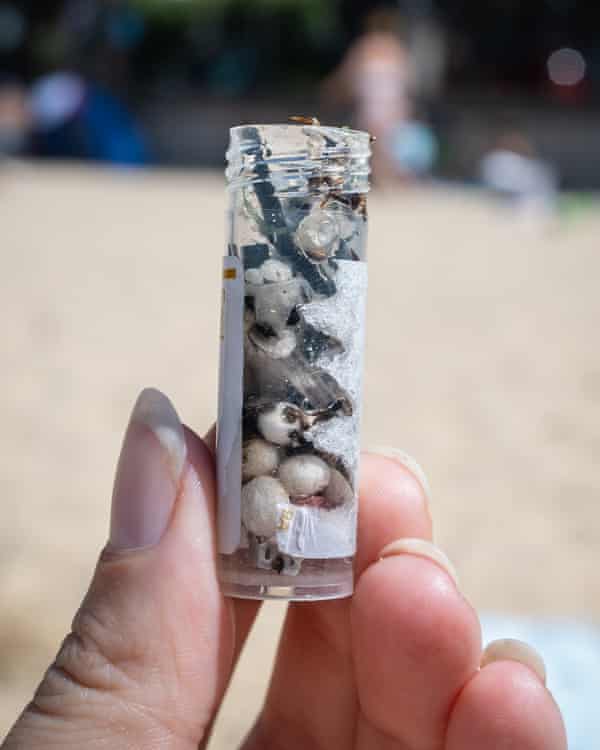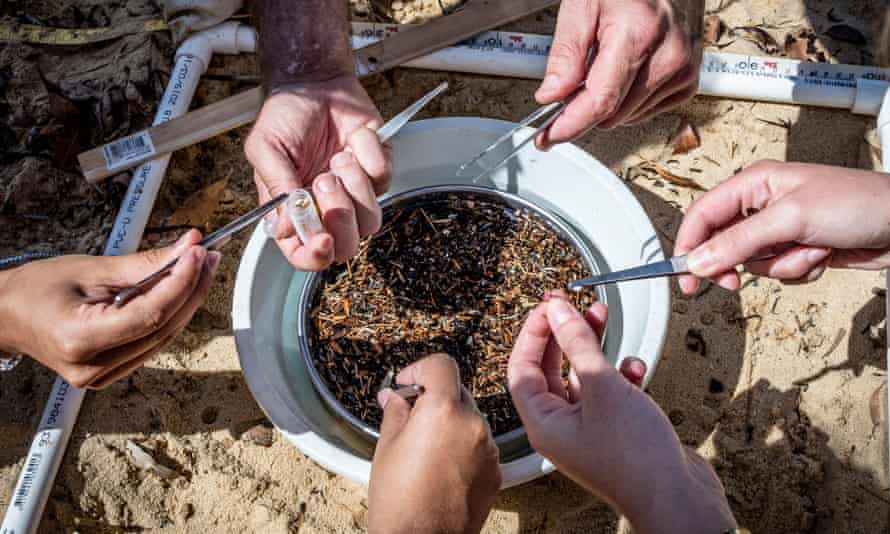Head down to Sydney’s Manly Cove on a weekend, and you might see groups of people crouching diligently on the sand. They’re not searching for shells or bloodworms, but something just as visually striking, not least because it shouldn’t be there: colored pieces of hard plastic, fragments of polystyrene foam and fibers from fishing line.
For the last three years, a group of volunteers has been surveying the beach each month for microplastics, as part of the Australian Microplastics Assessment Project.
Colloquially known as Ausmap, the citizen science project has collected more than 3.5m pieces of microplastic from more than 300 beaches around the country, ranging from Thursday Island in the north to Bruny Island, off Tasmania’s south-east coast.
Volunteers collect plastics between 1mm and 5mm in length; pellets, fibers and fragments are meticulously sorted and documented. “That’s what we can see easily in our sieves,” Ausmap’s program director, Dr Michelle Blewit, says.
“Microplastic doesn’t always refer to things that are microscopic,” she says. “Obviously it breaks up further and further… the smaller it gets, then there’s more chance of it being ingested by animals.”
Blewitt, a marine scientist, says more than 8,500 people have been involved in the project since its launch in 2018. Its goal is to quantify the scale of microplastic pollution across Australia, and help address the growing problem.
‘It can block the gut’
Microplastics – any type of plastic less than 5mm in length – are virtually everywhere. They are found in the most remote places on Earth, from the world’s deepest oceanic trench to its most pristine mountains. They are in the air we breathe, the tap water we drink, and the food we eat. They have been found in human placenta and poo. On average, we ingest about one credit card’s worth of plastic a week, according to 2019 Australian analysis.
“There are actually more microplastics on the seabed floor than floating on the ocean surface,” says Dr Denise Hardesty, a principal research scientist at the CSIRO.
The presence of microplastics in aquatic environments doesn’t necessarily equate to harm to wildlife, Hardesty says. But there is a growing body of evidence showing that microplastics have negative impacts on at least some marine organisms.
“For a really small animal organism, it can block the gut, it can make it so that an organism doesn’t feed as efficiently,” Hardesty says. “It can affect its reproduction, it can affect its lifecycle and trajectory.”
Microplastics have been found to make mussels lose their grip, and to alter the behavior of fish – one Australian study of damselfish found they were likely to take more risks and die earlier.

Also of concern is the accumulation of microplastics in animals further up the food chain. “We even find microplastics in plankton, which are really at the base of the food chain and help keep our oceans healthy,” Hardesty says. “We have everything from very small fish to very large whales that eat plankton.”
Plastics alone are one problem, but then there’s also the chemicals with which they interact. “Some of the plastics out there are quite porous,” Blewitt says. “Once out there in the environment, they can be attracted like a magnet to a whole bunch of other chemicals.”
“If an animal consumes these plastics, then they’re not only getting a dose of the plastic itself … but also whatever contaminants are attached to those plastics as well.”
Scientists are also concerned about interactions between plastic pollution and global heating on marine populations. A recent University of Sydney study found that fish grow slower when exposed to both the industrial chemical bisphenol A – a common compound used in plastics manufacturing – and higher temperatures.
“Discarded plastics – as they break down, they leach BPA that’s been used in their manufacture,” Prof Frank Seebacher, one of the study’s authors, says. “So wherever you have lots of manufacturing plants, lots of plastic pollution, you will find reasonably high levels of BPA.”
‘In the dark’ on health effects
What effects microplastics have on human health is still contentious. “We obviously can’t feed plastic to humans,” Blewitt says. “Health implications will probably rear their ugly head in the years to come.”
Prof Andreas Suhrbier, who leads the inflammation biology group at QIMR Berghofer, says while microplastics have been found to damage human cells under lab conditions, compelling evidence to date has been scarce.
“There is no consistent common understanding of if and what microplastic consumption would affect human health,” he says.
Suhrbier believes new research of his may provide a clue. TO recent study his team conducted in mice found animals that had ingested microplastics did not show any accumulation in internal organs, nor any significant changes in their microbiome.
Sign up to receive the top stories from Guardian Australia every morning
However, when they were exposed to a virus that resulted in arthritis, the mice who had eaten microplastics had joint inflammation for a significantly longer period. The team surmised that the microplastics activated immune cells that resulted in the inflammation.
The research squares with a separate study, published in December, which found significantly higher levels of microplastics in the faeces of people who had inflammatory bowel disease – Crohn’s disease and ulcerative colitis – than people who didn’t. The researchers also concluded there was a correlation between the concentration of microplastics in the gut and the severity of disease.
“Our emerging hypothesis is that plastic in the gut causes some level of inflammation,” Suhrbier says.
Less is known about the health effects of even smaller plastic particles, nanoplastics, at sizes ranging between 1 nanometer and 1 micron.

Dr Cheng Fang, a senior research fellow at the University of Newcastle, says in theory, nanosized particles can very easily “pass through the digestive system into the body, and can be transported by blood”.
His research has estimated that whipper snippers generate thousands of microplastics and billions of nanoplastics each minute when cutting grass. In January, scientists reported detecting nanoplastic pollution in polar regions for the first time.
“[We’re] really in the dark at this moment [about the health effects],” Fang says.
Tackling a big little problem
“Plastics and microplastics are ubiquitous,” Hardesty says. “They’re in our waterways, they’re in our stormwater drains, they’re being shed by tires from cars, they’re being shed from carpet fibers in people’s homes.”
She emphasizes the importance of prevention at the source, citing the need for reducing reliance on single-use plastic. “People focus on microplastics, but most microplastics start out as larger plastics,” she says. “It’s actually starting with changing some of our consumption behaviour, [and] plastics manufacturing all up.”
“We have power with what and how we choose to purchase,” Hardesty says. “Within Australia, we don’t need to buy bottled water.”
“Your can lobby your government… You can support buying in bulk and… speak up against some of the very hard to recycle items, like soft plastics, multi-layered laminates.”
By identifying microplastic hotspots, Ausmap is beginning to implement litter reduction strategies in certain coastal areas. They have installed nets to capture waste from stormwater outlets, “to identify which subcatchment is bringing down which kind of debris,” Blewitt says.
The project has identified Dee Why lagoon, in Sydney’s Northern Beaches, as a microplastic hotspot, with an estimated 3.1m pieces entering the area annually. “We were able to identify that nurdles – which are the resin pellets, the basis of plastic when it gets made in its base form – were coming down on one particular catchment,” Blewitt says.
With support from the NSW Environment Protection Authority, Ausmap has developed a micro-litter reduction strategy, which it is piloting in three catchments, Blewitt says.
“Hopefully we’ll be able to use this framework to be able to help identify where those potential hotspots might be … and then how do they stop it within their local catchment before it lands in the waterways as well.”
www.theguardian.com
George is Digismak’s reported cum editor with 13 years of experience in Journalism